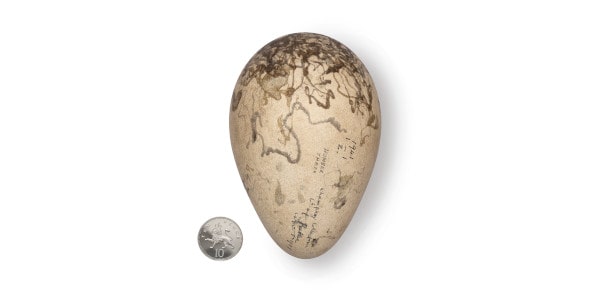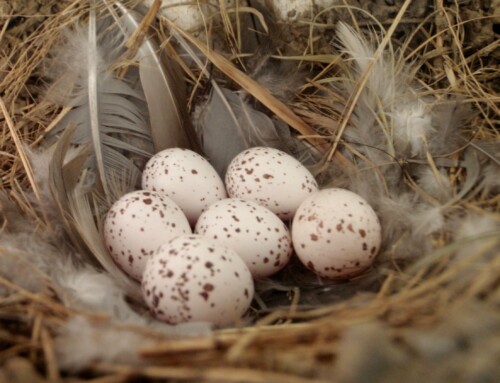LINKED PAPER
New insights from old eggs – the shape and thickness of Great Auk Pinguinus impennis eggs. Birkhead, T., Russell, D., Garbout, A., Attard, M., Thompson, J. & Jackson, D. 2020. IBIS. DOI: 10.1111/ibi.12820. VIEW
New ideas and new technologies help to drive science forward. Charles Darwin’s ideas of natural and sexual selection, Richard Dawkins’s popularisation of the idea of individual selection, Bill Hamilton’s idea of kin selection and Geoff Parker’s ideas about sperm competition all triggered huge changes our understanding of the natural world. Associated with the ideas of sperm competition, sexual selection and kin selection the development of molecular techniques, such as DNA fingerprinting and genome analysis allowed researchers to test those ideas in ways that Darwin, Dawkins and Parker could not have originally imagined.
Two relatively recent methodological and technological developments have similarly opened the door to help us better understand the biology of birds’ eggs. The first is a method for quantifying the shape of birds’ eggs — a problem that was once considered impossible (Romanoff and Romanoff 1949) or very difficult, at least for certain shapes (D’Arcy Thompson 1917). The new method developed by Biggins et al. (2018), based on methods pioneered by Preston (1953), provides quantitative measures for eggs of all shapes. The second is micro-computed tomography (micro-CT), a 3-D imaging technology that provides high-resolution images of microscopic structures. Invented in the 1980s, it was Riley et al. (2014) who saw the potential of using micro-CT to examine the complex microstructure of the avian eggshell.
In our recent study we used these two approaches to examine the eggs of the Great Auk Pinguinus impennis, at both a macro- and micro- level. Arguably the most iconic of recently extinct birds, the Great Auk was the largest member of the Alcidae during recent historic times. Uniquely among alcids it was flightless. In some areas, at least, the Great Auk bred in large numbers at high density, and as a result was desperately vulnerable to human predation. The last individuals are thought to have been killed in the island on Eldey off the south coast of Iceland in 1844.
All that is left are the wet-preserved body parts of two Eldey individuals, several skeletons, 78 skins and mounts and about 70 eggs. Great Auk eggs are now so scarce that when they occasionally come on to the market, they attract huge prices, and clearly such rare and valuable specimens must be handled with extreme care. Micro-CT is the probably the only safe and reasonable way of measuring the thickness of the shell in different regions of Great Auk eggs.
So much has been written about the Great Auk (Newton 1896; Grieve 1885; Bengtson 1984; and most recently by Fuller 1999). It is hard to imagine how it might be possible to find anything new to add to what we already know.
Our first objective was to measure the shape of the Great Auk’s egg, which is usually described as ‘pyriform’, meaning ‘pear-shaped’. While not a particularly accurate descriptor, it conjures up an image of an egg that it pointed at one end, very rounded at the other. This is the egg shape epitomized by that of the Common Guillemot (or Common Murre) Uria aalge and Brünnich’s Guillemot (or Thick-billed Murre) U. lomvia (both also members of the auk family) that Thompson (1917) considered so difficult to quantify.
There has been some recent controversy over the evolution of avian egg shape. Stoddard et al. (2017) proposed that egg shape has evolved in relation to ‘flight efficiency’, whereas my colleagues and I consider this unlikely and unconvincing (Birkhead et al. 2019). In the case of auks (and penguins) at least, the available evidence suggests that the nature of the incubation environment has exerted a strong effect on the evolution egg shape (Birkhead 2018, Birkhead et al. 2019). We have shown elsewhere that the Common Guillemot’s pyriform egg renders it inherently more stable on the bare, often sloping rock edges on which this species incubates (Birkhead 2018, Birkhead et al. 2018). In our recent paper in IBIS, we speculate that the Great Auk’s pyriform egg would have also rendered it more stable.
Our micro-CT scanning shows that the thickness of the Great Auk eggshell is greatest along that region where it would lie in contact with the substrate — that is, between the widest point and the pointed end. This is also true of the Razorbill Alca torda and the Common Guillemot, as we might expect for species that make no nest. However, comparing the relative thickness of different regions of the shell of these three species reveals some tantalizing differences. The Great Auk egg is relatively thicker (compared with the blunt end of the egg) than both of these other two species and especially compared the Razorbill, its closest relative. This suggests to us that like the Guillemot, the Great Auk incubated on bare rock, probably at high density amidst lots of other Great Auks, like Guillemots, but unlike Razorbills that always breed out of bodily contact with other Razorbills.

Figure 1 Geat Auks as we assume they might have bred. Artwork by David Quinn, from Birkhead (1990) Great Auk Islands. Poyser, London
It is always going to be difficult reconstructing the lifestyle of an extinct species for which there are very few detailed eye-witness accounts. But using Great Auk egg specimens held at the Natural History Museum at Tring has given us some additional insights into the life of the Great Auk that we might otherwise not have had without those new technologies.
References
Bengtson, S.-A. 1984. Breeding ecology and extinction of the Great Auk (Pinguinus impennis): anecdotal evidence and conjectures. Auk 101: 1–12. VIEW
Birkhead, T.R. 2017. The point of a Guillemot’s egg [Blog post]. The BOU Blog. Available at: https://www.bou.org.uk/blog-birkhead-guillemot-eggs/. VIEW
Birkhead, T.R. 2018. The shape of birds’ eggs [Blog post]. The BOU Blog. Available at: https://www.bou.org.uk/blog-birkhead-et-al-egg-shape/. VIEW
Birkhead, T.R., Thompson, J.E., Biggins, J.D. & Montgomerie, R. 2019. The evolution of egg shape in birds: selection during the incubation period. IBIS 161: 605-618. VIEW
Birkhead, T.R., Thompson, J.E. & Montgomerie, R. 2018. The pyriform egg of the Common Murre (Uria aalge) is more stable on sloping surfaces. Auk 135: 1020-1032. VIEW
Fuller, R. 1999. The Great Auk. Privately Published.
Grieve, S. 1885. The Great Auk or Garefowl Alca impennis, its History, Archaeology and Remains. Thomas C Jack, London.
Newton, A. 1896. Gare-Fowl pp 303-308 in A Dictionary of Birds. A. & C. Black, London.
Riley, A., Sturrock, C.J., Mooney, S.J. & Luck, M.R. 2014. Quantification of eggshell microstructure using X-ray micro computed tomography. British Poultry Science 55: 311-320. VIEW
Romanoff, A.J. & Romanoff, A.L. 1949. The Avian Egg. New York: Wiley
Stoddard, M.C., Young, E.H., Akkaynak, D., Sheard, C., Tobias, J.A. & Mahadevan, L. 2017. Avian egg shape: form, function and evolution. Science 356: 1249-1254. [Supplementary Material corrected and updated 10th September 2018]. VIEW
Thompson, D.W. 1917. On Growth and Form. Cambridge: Cambridge University Press
Image credit
Featured image: Great Auk (Pinguinus impennis) egg – the Spallazani Egg. Photo by Harry Taylor © The Trustees of the Natural History Museum, London
Author portrait: Tim R. Birkhead with Great Auk (Pinguinus impennis) egg. Photo by Harry Taylor © The Trustees of the Natural History Museum, London






